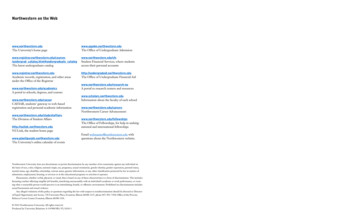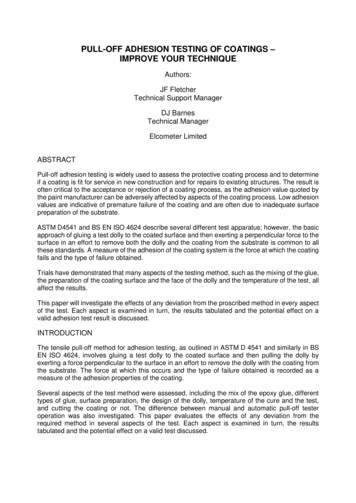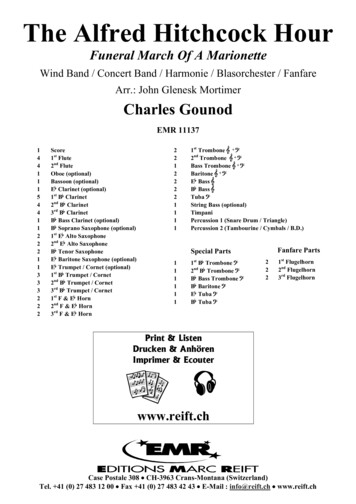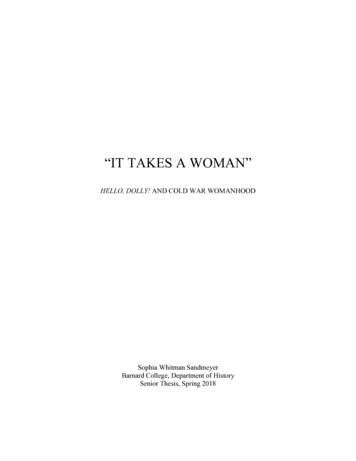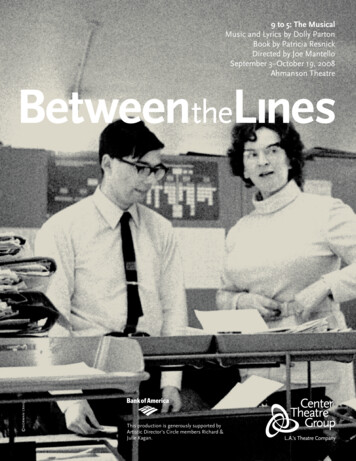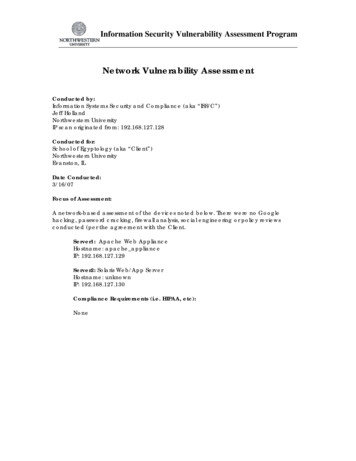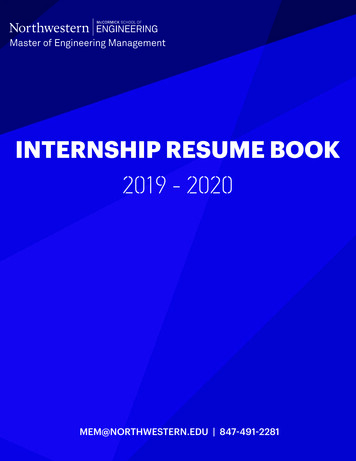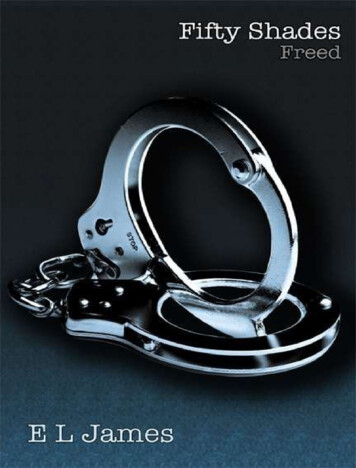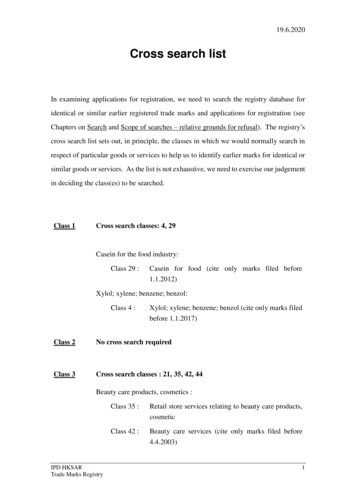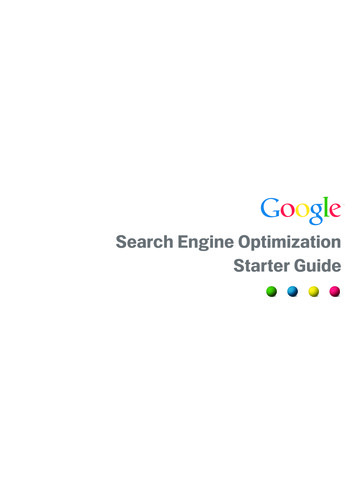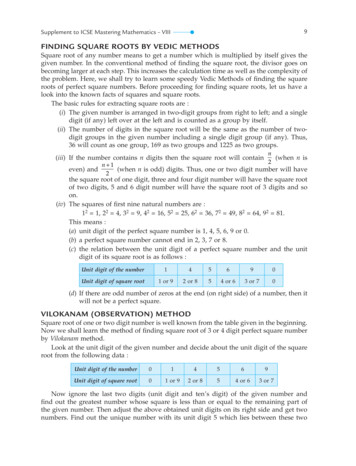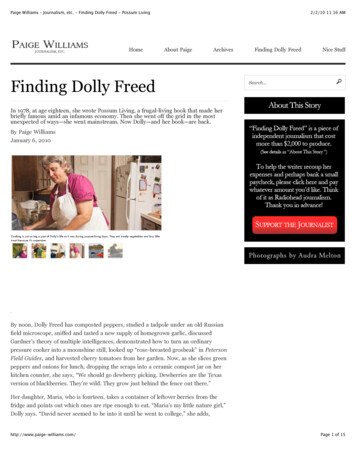
Transcription
Paige Williams – Journalism, etc. - Finding Dolly Freed - Possum LivingHome2/2/10 11:16 AMAbout PaigeArchivesFinding Dolly FreedNice Stuff.Finding Dolly FreedSearch.In 1978, at age eighteen, she wrote Possum Living, a frugal-living book that made herbriefly famous amid an infamous economy. Then she went off the grid in the mostunexpected of ways—she went mainstream. Now Dolly—and her book—are back.By Paige WilliamsJanuary 6, 2010.By noon, Dolly Freed has composted peppers, studied a tadpole under an old Russianfield microscope, sniffed and tasted a new supply of homegrown garlic, discussedGardner’s theory of multiple intelligences, demonstrated how to turn an ordinarypressure cooker into a moonshine still, looked up “rose-breasted grosbeak” in PetersonField Guides, and harvested cherry tomatoes from her garden. Now, as she slices greenpeppers and onions for lunch, dropping the scraps into a ceramic compost jar on herkitchen counter, she says, “We should go dewberry picking. Dewberries are the Texasversion of blackberries. They’re wild. They grow just behind the fence out there.”Her daughter, Maria, who is fourteen, takes a container of leftover berries from thefridge and points out which ones are ripe enough to eat. “Maria’s my little nature girl,”Dolly says. “David never seemed to be into it until he went to college,” she adds,referring to her son. “He called me and said, ‘Mom, I miss naturing.’ I said, ‘What’shttp://www.paige-williams.com/Page 1 of 15
Paige Williams – Journalism, etc. - Finding Dolly Freed - Possum Living2/2/10 11:16 AMreferring to her son. “He called me and said, ‘Mom, I miss naturing.’ I said, ‘What’s‘naturing?’ He said, ‘Just going out and doing nature-type stuff.’ The first day he washome from college, we went naturing. First we tried to catch a big leopard frog—wechased that thing all over the yard, but it got away. Then we went dewberry collecting—he’s picking dewberries up and down the road and I’m pulling out invasive species.”David attends Lamar University, which is in Beaumont, Texas, and across the road froman oil refinery. “There’s no naturing there,” Dolly says.Her neighbors might assume there’s no naturing amid the strip malls and cul-de-sacsand fast-food pit stops of suburban Houston, either, but Dolly knows otherwise. Shelong ago made a wildlife sanctuary out of her once-barren backyard. Shecommandeered a neighbor’s mosquito-magnet swimming pool and turned it into ahome for goldfish and minnows. After summer rains, she nets out the minnows andtransfers them to stagnant puddles, where the minnows eat mosquito larvae. Theswimming pool’s owner didn’t love the idea of the minnows being deployed as a link inthe food chain only to die when the puddles dried up, but he allowed it; he said no,though, when Dolly wanted to raise catfish, for eating.Dolly gardens on a patch of lawn at the end of her paved driveway, and on half of thedriveway itself, where she built raised beds. There she tends eggplant, arugula,soybeans, Swiss chard, snap peas, asparagus, green beans, cauliflower, peppers, and,this time of year, winter greens. The summertime driveway is a forest of gangly tomatostalks, which stand in enormous plastic pots that Dolly hauled from neighbors’landscaping projects and re-used.Friends and neighbors who have seen Dolly coaxfood from concrete ask her to teach them how todo the same, and Dolly does. She volunteers innature and environmental education programsthroughout Texas and is known for her work.“She has volunteered thousands of hours workingwith students, parents, teachers, and communityvolunteers,” the awards committee wrote whenDolly won third place in a 2003 EPA contest forcreating an elementary school wetlandsprogram.“The wetland habitat—two ponds—thatshe designed and installed with volunteers wasdescribed as ‘awesome’ by one of her many fans.”Fans—that’s another subject Dolly knowssomething about, or used to. Most of the Texanswho seek Dolly out for nature training or advicehave no idea whom they’re talking to. They knowher by her real name, not as “Dolly Freed,”author of Possum Living: How to Live WellDolly's garden, and seedlings in abirdbath (photograph by AudraMelton)Without a Job and with (Almost) No Money, a book that in the late 1970s made Dollyone of the most famous teenagers in America.She wrote the book at age eighteen, drawing her ideas about self-sustenance and thrifthttp://www.paige-williams.com/Page 2 of 15
Paige Williams – Journalism, etc. - Finding Dolly Freed - Possum Living2/2/10 11:16 AMfrom the semirural life she and her father, Frank, lived outside of Philadelphia. Theeconomy was as dismal as the one we’re in now, but Dolly and Frank were quite happyto have no jobs—they rejected the “money economy,” choosing instead to make theirown way and avoid the “gracious living” and acquisition-based one-upmanship thatseemed to make so many other Americans miserable. “We have and get the good thingsof life so easily it seems silly to go to some boring, meaningless, frustrating job to getthe money to buy them,” Dolly wrote, “yet almost everyone does. ‘Earning their way inlife,’ they call it. ‘Slavery,’ I call it.” She and Frank referred to their existence as“possum living” because “possums can live anywhere.”Possum Living contains twenty chapters with titles such as “We Quit the Rat Race,”“Health and Medicine,” and “Meat.” It includes instructions for mending clothes,pickling vegetables, and buying bargain homes in what Dolly called “sheriff sales” andeveryone now calls foreclosure, plus recipes for the kind of food she and her fathercooked and ate, like creamed catfish, rocket pickle, and dandelion wine. “We aren’tliving this way for ideological reasons, as people sometimes suppose,” she wrote of thehome she called Snug Harbor. “We aren’t a couple of Thoreaus mooning about onWalden Pond here. We live this way for a very simple reason: It’s easier to learn to dowithout some of the things that money can buy than to earn the money to buy them.”The lessons aren’t for everyone, since most people aren’t planning to shoot a turtle inthe head and turn it into soup. The larger charm of Possum Living is its timelesssensibility and voice—on the page (and in person, for that matter) Dolly Freed is like across between E.B. White and Dorothy Parker, but bearing rabbit sausage andhomemade gin. “There’s an abandoned orchard in our neighborhood and we getpeaches, pears, cherries, and apples there, free,” she wrote. “None of the neighborsbother with them—they apparently don’t consider food to be food unless it’s bought and1paid for in a licensed grocery store.”It isn’t often that readers encounter a recipe for fishballs in the same book thatmentions Diogenes, Napoleon, Darwin, Wagner, Demosthenes, sixth-centuryConstantinople, and Ecclesiastes, but Dolly wrote as economically as she dressed rabbitsfor braising, wasting nothing. She dropped in the occasional Dollyism: “Quality candlespractically sell themselves,” and “Math is a pretty good opiate to dull the pain of aNortheast winter.”Possum Living sales figures are long gone, yet we know the book was compellingenough for Random House to reissue less than a year after the original debuted, and forthe New York Times and Seventeen magazine, and others, to run stories, and for MervGriffin to invite Dolly out to L.A. and put her on The Merv Griffin Show, and for ayoung filmmaker named Nancy Schreiber to make an award-winning shortdocumentary about her. Tin House, a publisher in Portland, Oregon, has just reissuedPossum Living as a 12.95 paperback. The new edition includes a foreword by thenovelist David Gates, who in 1985 came across a copy of Possum in the attic of afarmhouse he’d bought in upstate New York. His first novel, the Pulitzer Prize finalistJernigan, features a bunny-slaughtering suburban survivalist character partly based onDolly, and in his acknowledgments he credited her book for inspiring his own.“Whatever Freed or her publishers thought Possum Living was, I see it as both a classicof American cantankerousness and a cryptic autobiography,” he wrote in thenew Possum Living. “ Here and there [Dolly Freed] gives glimpses of a rancorous,http://www.paige-williams.com/Page 3 of 15
Paige Williams – Journalism, etc. - Finding Dolly Freed - Possum Living2/2/10 11:16 AMnew Possum Living. “ Here and there [Dolly Freed] gives glimpses of a rancorous,downwardly mobile, borderline-violent milieu, something like the world of hercontemporary Raymond Carver.”The Tin House edition also includes an afterword—the first word from Dolly Freed toher fans in three decades. You might think she’d want to take full credit for the bookafter all these years, especially considering the scrappy resourcefulness required tocreate it. But while she’s proud of her work she’s not especially keen to find strangers ather door. Fame interests her not in the least. Money doesn’t interest her much, either.Dolly rather prefers to spend her time planning the spring planting from the BurpeeSeeds catalog or talking to her children and husband or studying the birds that flock totheir backyard, where this time of year so many male cardinals line up on pine boughsto wait their turn at the feeders, they look like a tree full of Christmas ornaments.“If there’s one thing possum living taught me, it’s that you need very few physical thingsto be happy,” she says. “Water, food, shelter, good heath, security, and liberty—that’s it.Everything else is mental.”1978: Snug HarborNaturally, this started with a boy and a girl. Marie at sixteen liked the sandy-hairedlooks and smarts and smooth talk of the gangly guy in the Air Force uniform. This wasin suburban Philadelphia and the boy’s name was Frank. And as for Marie, Frankalways said she was “built like a brick shithouse,” which apparently was a compliment.Frank and Marie got married and moved to Titusville, Florida, so Frank, a militarytrained electronics technician, could work on rockets for Martin Marietta, a NASAsubcontractor. Dolly was born nine months and four days after the honeymoon.Whenever the rockets fired, Marie took Dolly to watch from the beach. Dolly spent herformative years near the manifestation of the most ambitious dreams of modern man.On the other hand, she was grounded: tenderfooting with her father through mudflatsin search of clams.When Frank got tired of Florida, he moved Marie and Dolly and, by then, baby Carlback to Pennsylvania. Frank and Marie had split up before, and though Marie would fallin and out of love with him for more or less seventeen years, they were on the verge ofdivorce. They had moved around a lot, chasing cheap rent, even living for a while in abarn, and this time they took up residence in Pennsburg, in a renovated gas station: anarrow, three-story, wood-frame fixer-upper that Frank bought “free and clear” for 6,100 at a sheriff’s sale.Frank increasingly wanted to fish and read and grow his own food and not be bothered2by more material things; Marie, a candle maker , liked brightly painted walls, andknickknacks, and sofa pillows. She had no interest in a life of itinerancy or a big gardenor turtle soup. This world was too drab for her, too iffy. Dolly was fourteen when Mariemoved out for good, taking Carl with her. Carl was fine with that—he hated the simplelife.Dolly, on the other hand, couldn’t get enough of it. She and Frank understood eachother perfectly. No one had ever related to Frank as well as Dolly did—Frank respectedhttp://www.paige-williams.com/Page 4 of 15
Paige Williams – Journalism, etc. - Finding Dolly Freed - Possum Living2/2/10 11:16 AMother perfectly. No one had ever related to Frank as well as Dolly did—Frank respectedhis daughter’s mind and common sense so much he gave her equal say, a full vote,which was more than Marie and Carl ever felt they got.Once Marie and Carl were gone (not far; they took an apartment nearby) Dolly andFrank carried on. They lived on a half acre and had land all around: orchards andwooded hills and deep streams and, a short walk away, Green Lane Reservoir. Frankhad always kept a garden and favored fallen fruit over store-bought food, and now hepursued this life almost to the exclusion of all else. He showed Dolly how to plant andtend vegetables and harvest and fish. They grew beans and corn and dried their ownherbs. They cooked bass and sunfish on an outdoor fire. In the cellar and in backyardpens they raised rabbits, which they named and then fattened, killed, and ate. Othertimes they sold rabbits, these being New Zealand whites and this being customary in theland of German immigrants and hossenfeffer, a dish with braised rabbit.In school, Dolly made it to halfway through the seventh grade.3She hated the place and often came home crying. She wantedto be outdoors, exploring, not inside doing homework, andFrank did not disagree. He believed compulsory education to4be pointless and full of idiots. When Dolly brought home aform to be filled out—asking for family income and Socialcourtesy dolly freedSecurity numbers—Frank went to Dolly’s school and told theprincipal they were moving to California, which of course theyweren’t. Dolly never went back to school another day.During school hours she stayed indoors, a truant. It was the mid-1970s and home5schooling wouldn’t be legal for years yet. Frank educated her by assigning her to read(and discuss) Mathematics for the Million: How to Master the Magic of Numbers, byLancelot Hogben, and many more of his hundreds of books, on history, physics, politics,philosophy. When they weren’t gardening or fishing or swimming, Dolly and Frankread, or listened to radio, or ran to the cow pasture and back, or argued about calculi.They woke up early and went to bed late. They cooked—fish pesto, creamed onions andpeas, string beans, fried snapper, spaghetti, peach preserves, carp eggrolls, orangemarmalade cookies, homemade candy, nasturtium salad, wheat cakes. They picked peasby flashlight and ate them with bunny liver in tomato sauce.They had no television and, for the longest time, no car. For luxuries there was indoorplumbing, and electricity, though often they ate by candlelight. Among their few storebought groceries were grains and the aforementioned tomato sauce. In winter theydragged their mattresses downstairs, closed off the upstairs, and stayed warm by awoodstove crafted from a junked oil drum, which smoked. They shopped for theirclothes in thrift stores.When they needed money, Frank temped or landscaped or fixed computers and other6electronics. Other times, they grudgingly made candles. Marie had taught them how.7Dolly kept a journal in composition notebooks. On the cover she scrawled “DO NOTUSE!” and drew skulls and crossbones in green magic marker. She wrote details of her8and Frank’s life in adolescent print, recording everything: birds she spotted, flowersshe was researching, how she felt (she tended to feel “metaphysical” after naps), how farhttp://www.paige-williams.com/Page 5 of 15
Paige Williams – Journalism, etc. - Finding Dolly Freed - Possum Living2/2/10 11:16 AMand fast she ran, what time she went to bed, what she and Frank ate, whether theyargued, the weather report. She documented her attempts to learn shorthand and the“universal” language Esperanto. On her sixteenth birthday, in June 1975, she madescrapple for breakfast, counted the number of roses blooming in her yard, bartered witha neighbor for ten pounds of sugar, read in her bedroom, ate garlic sandwiches andwatermelon for lunch, adopted a three-inch-long baby snapping turtle, and wentswimming in the creek, where she watched her father net eight minnows. “On the wayhome, daddy was joking about how the rain would save the crop and we could pay themortgager for the place we had wrested from the prairie and Indians,” she wrote. “[Hewas] calling me Mary Lou and I was telling him I was going to kick him in the ass. Wedidn’t know there was a fisherman nearby listening—[he] left in a hurry with nary abackward glance. Me and Daddy laughed and laughed.”A couple of weeks later, on the Fourth of July, she wrote, “For lunch we had fried fishand creamed peas and onions that I made—very good. In the afternoon, I cleaned thekitchen. Then went out and killed a million asparagus beetles, eggs, and worms.Weeded lily bed, a few seeds are coming up: the nasturtiums were looking nice and Ikilled aphids on the columbine. Daddy killed Brindle and we dressed her.” OnSeptember 14: “Weather—sunny, a few clouds, cool, brezzy [sic]—nice! Comments—cleaned the kitchen, then killed a bunny and washed my hair. Got a job babysitting 4days this week for 2 an hour. Felt—good but ocaisionaly [sic] irritable.”Between August 1, 1975, and August 1, 1976, Dolly and her father, a.k.a. “the Old Fool,”spent 1,498.75. “When I totaled up the figures and handed them to Daddy, his facewent all white,” she wrote. “Then he sat down and checked that his heart was stillworking okay. ‘Impossible!’ he shouted. ‘Where did it all go?’”Frank and Dolly had never planned to drop out of society—they just sort of woke up oneday and were doing it, or at least the money part of it. They weren’t socially isolated—Dolly would have boyfriends and go out with friends—they simply needed far less thanother people did, especially when it came to possessions and status.And good thing. It was the mid-1970s (Ford was president), and the American economywas caught in the worst crisis since the Great Depression. The postwar industrial boomseemed to be over as formerly war-crippled nations like West Germany and Japanregained their balance and began to grow in power. The U.S. was losing its place in theinternational market. Inflation and unemployment were rising and energy supplies wereshrinking. Americans were buying foreign, but other countries weren’t buying American.As manufacturing jobs disappeared, the service industry became the fastest-growingeconomic sector, yet those jobs paid less than industrial jobs and came with fewerbenefits. All along Dolly and Frank’s mountain ridge, neighbors were out of work.Dolly got the idea that writing about her and Frank’s lifestyle would help mankind. Shewanted others to know they didn’t have to panic if they lost their jobs, that it’s possibleto live on very little money. “In this book you will find much practical information forsaving money, but telling you how to do so isn’t my only goal,” she wrote in theintroduction. “Frankly, I hope to inspire you to do some independent thinking abouteconomics as it affects the course of your individual life now and in the coming ‘age ge 6 of 15
Paige Williams – Journalism, etc. - Finding Dolly Freed - Possum Living2/2/10 11:16 AMShe wrote longhand in notebooks over the course of a few months, consulting withFrank on important points such as whether armadillo does or does not make a tastysupper. She typed the manuscript on a secondhand typewriter that her mother gave herin a deal: one secondhand typewriter for one GED. To find an agent, she looked upnames at the public library.Universe, on Park Avenue, bought the manuscript for 10,000 and published PossumLiving in October 1978. Seven months later, Bantam (now Random House) reissued thebook as a mass-market paperback that sold for 3.95 in bookstores and in the WholeEarth Catalog.After the book came out Dolly and Frank banked the ten thousand and she went on herpublicity tour: TV, radio, newspapers, magazines. Dolly visited Schreiber in New Yorkand stayed in her downtown loft—they went to parties and to dinners, and Dollylearned to hail taxis by watching how New Yorkers did it. She missed home and hergarden yet thought, “I can get around in the world. I can do this.”She was a tall, slim, pretty young woman with bright blue eyes, a clean-scrubbedcomplexion, and curly brown hair. She transfixed readers and viewers with her maturityand personality: no nonsense but warm, and apparently unfazed by all the attention. Inthe makeup chair for Merv Griffin, she explained to the makeup artist how he, too,could drop out.“The techniques of it are easy,” she said, “they’re very simple to learn.”“And where do you live?” the makeup artist asked.“Outside of Philadelphia, Pennsylvania.”“So now that you’re here in California, are you ready to switch?”“What? No,” Dolly said. “Are you kidding? I’m gonna go home, back to my rabbits andchickens.”“Was it something I said?”“No, it’s not you. It’s—I don’t know, all the hustle and bustle. Man oh man, where dopeople find the time to do anything?”“Yeah but after being on the Merv show, show business will be your life,” he said.“Ah, wanna make a bet?”At the time she wrote Possum Living, Dolly had one life plan: to build a boat with herfather and sail down the eastern seaboard. When interviewers asked if she intended tomarry and have a family, Dolly said no. College was also out of the question, notbecause she had dropped out of school but rather because the thought of it agitatedFrank. He didn’t want Dolly to leave.Dolly did go back to her rabbits and chickens after Merv, yet remembered howinteresting she had found the outer world. Possum living had led to Possum Living,which led her to think about new challenges, and away from Frank.http://www.paige-williams.com/Page 7 of 15
Paige Williams – Journalism, etc. - Finding Dolly Freed - Possum Living2/2/10 11:16 AM1980: Rocket ScienceFrank was pretty sure a college education would ruin Dolly’s life. They argued about herplans to go.His fears went deeper than concerns about poor teachers, though. Marie remembered amoment that she thought perfectly described the emotions that drove some of her exhusband’s erratic behavior: They were once out driving, the two of them, and came upona country funeral in a hilltop cemetery. No one was there at the coffin but the preacherand a couple of gravediggers. Frank started crying. He told Marie he couldn’t imagineanything worse than dying alone.9Literally and figuratively he had created Dolly. And Dolly loved and respected her10father. At his best he was charming and fun, but at his worst he was cranky,controlling, frightening. Early in his marriage to Marie he wouldn’t let her wear makeupor stay close with her family; she came home once to find her crystal in the garbage—Frank didn’t like how much time she spent dusting it. Get a little homemade wine in11him and he could act even worse.Dolly was the only person who’d been able to put up with his moodiness, hismanipulativeness. She accepted and even endorsed his crazy behavior, his moral code.“Once, when we were still in the money economy, a cutey-pie of a realtor got hold of12several thousands of [our dollars] by sheer fraud and wouldn’t give it back,” Dollywrote. “He spouted fountains of legal technicalities. Daddy assured us that a man—anyman—is a reasoning creature and can be reasoned with. ‘He knows he’s being dishonestand so I’ll just reason with him,’ said Daddy. ‘First, though, I may have to catch hisattention.’ So Daddy looked up his address in the county Recorder of Deeds office, thenvisited his house late one night and caught his attention. Sure enough, once the realtor’sattention was caught he realized his rotten ways were wrong and returned the money.Even paid interest on it.”13Dolly left home not for fear of becoming an outlaw like her father; she left mostlybecause she was young and bored with possum living and because she couldn’t helpthinking about the possibilities of a future beyond Pennsburg. She and Frank had spentpart of the book money on a second-hand Opel car and a real woodstove; the rest theysplit. Dolly now used hers for school and supplemented it by working in a machine shop14that made customized vacuum furnaces.15She followed a boyfriend to Rutgers , then transferred to Temple, and ended up atDrexel University, in Philadelphia. All the while she worked: as a self-employed16housemaid, office cleaner, tutor, ditch digger, and night manager of a kennel.The longer Dolly stayed away, the clearer it became that she intended never to comehome. Frank’s alcoholism and aggression got worse. He scared the family, scared theneighbors; he wrote nasty letters to Dolly. “He threatened me, my boyfriends, mybrother, my brother’s wife, my mother, my friends; he even threatened to hurt himself,”she wrote in the afterword of the new Possum Living. “We tried hard to get him helpand thought of having him committed, but he adamantly refused to accept help.”Meanwhile, Dolly excelled at school. Her grades were exemplary for any student, muchless one with a seventh-grade formal education: A’s in Aerodynamics, Fluid Mechanics,http://www.paige-williams.com/Page 8 of 15
Paige Williams – Journalism, etc. - Finding Dolly Freed - Possum Living2/2/10 11:16 AMless one with a seventh-grade formal education: A’s in Aerodynamics, Fluid Mechanics,Fluid Dynamics, Physics III, Physics IV, and the highest levels of calculus, as well as inEnglish comp, Technical Writing, Economics, and Psychology.Drexel had appealed to her because it had a NASA co-op study program—which accepted her into its ranks of would-be rocket scientists and trained her at theLangley Research Center in Hampton, Virginia, from June to December 1983, andthroughout the summer of ’84. While working in the Configuration AeroelasticityBranch of the Loads and Elascticity Division, for example, she designed a fluttersuppression support system for model wings used in wind-tunnel tests. She describedher NASA projects with the same break-it-down simplicity of Possum Living: “[Flutter]is caused by the interaction between aerodynamic forces, elastic reactions of the plane,and inertial forces,” she wrote in July 1983, in one of her regular progress reports. “Awing can vibrate so violently it breaks into pieces. In the tunnel we need to test themodel wings to the point of flutter, but we want to stop the flutter quickly to preservethe model.” Dolly’s supervisors consistently evaluated her as outstanding. Dolly enjoyedher assignments because they reminded her of her old job in the machine shop.17And her social life? “By then I had learned not to say too much about my possum livingdays,” she says. “Starting a conversation with things like ‘Have you ever watched a flockof geese sleep at night?’ or ‘You know how when you go spearfishing for spawningsuckers ’ or ‘Even though I’ve had road-killed dog and it was very good, I wouldn’tkill a dog just to eat it’ just makes people stare at you,” she says. “Don’t try theseopeners yourself—trust me it’s a mistake.”Yet at NASA she met Pete, another young scientist. And, well, what can she say? DollyFreed fell in love.1985: TexasDolly graduated from Drexel in June 1985, seven years after the publication of PossumLiving. Her next life began.She and Pete got full-time jobs with NASA as aerospace engineers at the Johnson SpaceCenter outside Houston. Dolly worked in the Structures and Mechanics Division forabout 24,000 a year. They got married.They lived in cheap rentals until they paid off their school loans. When they decided tobuy, they waited for a downturn and bought a house. “Piles of dead roaches were on thecounter, the owners have smoked inside for ten years, they had never cleaned, the dogwasn’t housebroken, the carpet was a hideous bright green shag, and the gold-coloredwallpaper was rotting and falling off in chunks,” she says. “Talk about perfect!”NASA had hired Dolly for her “knowledge in the use of finite element technology tosolve for deflections, internal loads, stresses, natural frequencies, etc., of complicatedstructures,” these being spacecraft and space station components. In other words, shetested things. And after the space shuttle Challenger exploded, in January 1986, Dollyand a small group of colleagues traveled to Cape Canaveral for a Challenger DebrisSeminar. They toured the launch pad, the vertical-assembly building, and the orbiterprocessing facility (where both the space shuttles Columbia and Discovery were beingrefurbished), and spent more than an hour walking on their own amid the vast andhttp://www.paige-williams.com/Page 9 of 15
Paige Williams – Journalism, etc. - Finding Dolly Freed - Possum Living2/2/10 11:16 AMrefurbished), and spent more than an hour walking on their own amid the vast andsobering Challenger debris. Two decades after watching spaceships fire in flight, shewas back in the same place, trying to understand why one had come apart, costing sevenhuman lives.Later that year, NASA promoted Dolly and raised her salary by more than 13 percent,but Dolly had started volunteering at a nature center and was already thinking about18getting back to her outdoorsy life. While Pete stayed on at NASA , Dolly left to earn a19master’s degree in science education. She then began her work as a naturalist and hasbeen passing along lessons about gardens and wetlands and wildlife for more than twodecades.Possum Living, meanwhile, all but disappeared. The book went out of print and becamea collector’s item—first-edition copies sell on Amazon.com for 95 or more. Between2002 and last year, an obscure Australian soil-and-health library alone distributed9,000 free, downloadable copies of Possum via its website, until Tin House asked thelibrary to stop.All along, Dolly’s elusiveness seemed to drive her popularity. “I found this book in the‘free’ box outside a used bookstore and I have read it so many times it is falling apart,”a Californian wrote nine years ago on Amazon.com. “It is wise, inspirational, and veryentertaining. Like her other fans, I would like to know what has become of the author inthe 20 years since the book was written.” In 2008, a Maine woman wrote, “Dolly is myinspiration. It was finding her book that made me realize how shallow my life of ‘stuff’was.” Some speculated that Dolly had died or dropped out of society. One reader said, “Iwish we knew more about her.”2010: “Half-Possuming”The girl of eighteen is st
peaches, pears, cherries, and apples there, free,” she wrote. “None of the neighbors bother with them—they apparently don’t consider food to be food unless it’s bought and paid for in a licensed grocery store.” 1 It isn’t often that readers encounter a re
